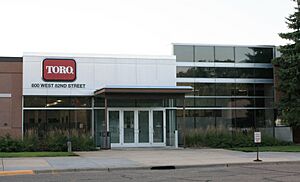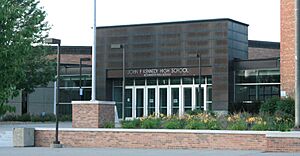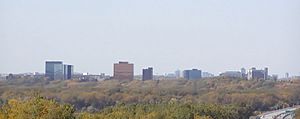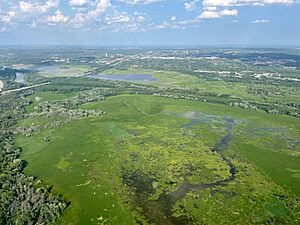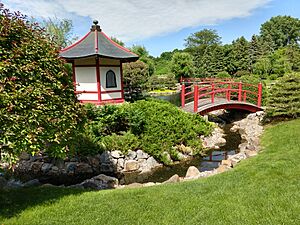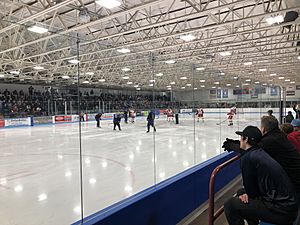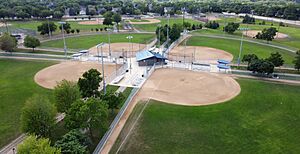Bloomington, Minnesota facts for kids
Quick facts for kids
Bloomington, Minnesota
|
|
|---|---|
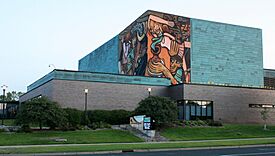
Bloomington City Hall & Arts Center
|
|
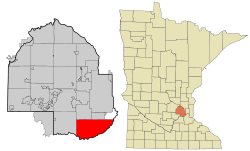
|
|
| Country | United States |
| State | Minnesota |
| County | Hennepin |
| Founded | 1843 |
| Incorporated (town) | May 11, 1858 |
| Incorporated (city) | November 8, 1960 |
| Government | |
| • Type | Council-manager |
| Area | |
| • City | 38.395 sq mi (99.443 km2) |
| • Land | 34.699 sq mi (89.869 km2) |
| • Water | 3.696 sq mi (9.574 km2) 9.73% |
| Elevation | 827 ft (252 m) |
| Population
(2020)
|
|
| • City | 89,987 |
| • Estimate
(2023)
|
87,398 |
| • Rank | US: 400th MN: 5th |
| • Density | 2,518.76/sq mi (972.49/km2) |
| • Metro | 3,712,020 (US: 16th) |
| Time zone | UTC–6 (Central (CST)) |
| • Summer (DST) | UTC–5 (CDT) |
| ZIP Codes |
55420, 55425, 55431, 55435, 55437, 55438
|
| Area code(s) | 952 |
| FIPS code | 27-06616 |
| GNIS feature ID | 0640278 |
| Sales tax | 9.025% |
Bloomington is a cool city in Hennepin County, Minnesota, USA. It's located on the Minnesota River, about 10 miles south of downtown Minneapolis. This city is also just south of the main highway loop, I-494. In 2020, nearly 90,000 people lived here, making it the fifth-largest city in Minnesota!
After World War II, many new homes were built here. The city is easy to get around thanks to major highways like I-35W, Minnesota State Highway 77, Highway 169, and Interstate 494. Many big businesses and shops are found along the I-494 highway. Bloomington has tons of parks, with lots of green space for everyone. You can also visit Hyland Lake Park Reserve and the Minnesota Valley National Wildlife Refuge.
Bloomington has more jobs than Minneapolis or Saint Paul. This is partly because it's home to the Mall of America. This huge shopping center has over 500 stores and even an amusement park called Nickelodeon Universe. Many companies have their main offices here, like Dayforce, Donaldson Company, Great Clips, Dairy Queen, HealthPartners, Holiday Stationstores, and Toro. The city was named after Bloomington, Illinois.
Contents
History of Bloomington
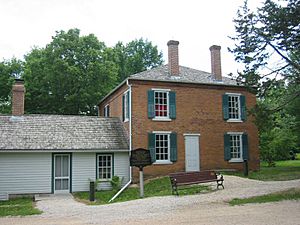
In 1839, a Native American leader named Chief Cloud Man moved his group of Mdewakanton Sioux to an area in southern Bloomington. In 1843, Peter and Louisa Quinn became the first European settlers in Bloomington. They built a cabin by the Minnesota River. The government sent them to teach Native Americans how to farm like Europeans.
Later that year, Gideon Hollister Pond, a missionary, also moved to the area. He built a log cabin and started Oak Grove Mission. Pond and his family held church services and taught the Dakota people. In 1849, William Chambers and Joseph Dean started the Bloomington Ferry, which helped people cross the Minnesota River. This ferry ran until 1889.
After a treaty in 1851, the land west of the Mississippi River was opened for settlers. Families like the Goodrich, Whalon, and Ames families moved to Bloomington. They named the area after their hometown, Bloomington, Illinois. Most early jobs were in farming, blacksmithing, and flour milling. The Oxborough family opened a trading center called Oxboro Heath. Today, the Clover Shopping Center is near that old site. In 1855, the first public school opened in Miss Harrison's house. The first school building, Gibson House, was built in 1859.
On May 11, 1858, the same day Minnesota became a state, 25 residents officially made Bloomington a town. By 1880, the population had grown to 820 people. In 1892, the first town hall was built.
Growing into a City (1900s to 1930s)
After 1900, Bloomington's population grew to over 1,000. The town started to become a city. People had different ideas about how the city should grow. One big issue was whether to combine all the small schools into one larger school. By 1900, there were six small schools with over 200 students. In 1917, voters agreed to combine the schools. A year later, high school classes and school bus service began. Telephone service and automobiles also started to appear.
Fast Growth (1940s to 1950s)
From 1940 to 1960, Bloomington's population grew nine times larger! This fast growth was partly because of the "baby boom" after World War II. In the 1940s, the city planned for many affordable, single-family homes. Each home would have its own water well and septic system. In 1947, the first fire station was built, and the Bloomington Volunteer Fire Department started with 25 members.
The 1950s brought big changes to Bloomington. The city started to feel less like a small town. In 1950, the first elementary school, Cedarcrest, was built due to the growing population. Ten new schools were built in this decade to keep up. In 1952, the first large business, Toro Manufacturing Company, moved to Bloomington. Today, Bloomington has hundreds of businesses.
In 1953, Bloomington changed its government from a township to a village. This new government held open meetings and made plans for land use and budgets. The city's police department was formed, and the first parkland was bought. Bush Lake Beach and Moir Park were created. Today, about one-third of the city is parks and open spaces. In 1956, the city started its first land-use plan. This included building I-35W and Metropolitan Stadium.
In 1957, Bloomington High School opened. In 1958, the city changed its government again to a council-manager system. The council wanted to encourage more businesses, affordable housing, and shopping centers. Police and fire departments started 24-hour service.
Sports and Schools Expand (1960s to 1970s)
The 1960s saw more schools and businesses grow. On November 8, 1960, Bloomington officially became a city. In 1965, a second high school, John F. Kennedy High School, was built. Bloomington High School was renamed Abraham Lincoln High School. More fire stations were built to serve the growing city. In 1968, Normandale State Junior College opened. In 1974, it became Normandale Community College.

From 1961 to 1981, Bloomington was home to most of Minnesota's major sports teams. In 1961, the Minnesota Twins (baseball) and Minnesota Vikings (football) began playing at Metropolitan Stadium. The stadium was made bigger for these teams. The first Twins game was on April 21, 1961. The first Vikings game was on September 17, 1961. On August 21, 1965, The Beatles even played a concert there! In 1967, the Metropolitan Sports Center was built for the Minnesota North Stars (hockey).
Many new city buildings were built in the 1970s. In 1970, Thomas Jefferson High School, the first rink at Bloomington Ice Garden, and a fourth fire station were built. School enrollment peaked in 1971 with 26,000 students.
Modern Bloomington (1980s to Present)

The 1980s brought big changes as the Twins and Vikings moved away. On September 30, 1981, the last baseball game was played at Metropolitan Stadium. The teams moved to a new stadium in Minneapolis. In 1985, the land where the stadium stood was bought. In less than two years, plans for the Mall of America were approved. The mall opened in 1992. Today, the Mall of America is the biggest private employer in Bloomington, with about 13,000 people working there.
In 1993, the Minnesota North Stars hockey team moved to Dallas. A year later, the Metropolitan Sports Center was torn down. In 2004, an IKEA store opened on part of the old stadium site. In May 2006, the Water Park of America opened. It is one of the largest indoor waterparks in the country.
In 2023, Bloomington was considered to host the Expo 2027, a big international event. However, Belgrade, Serbia was chosen instead.
Geography and Nature
Bloomington covers about 38 square miles. Most of this is land, but about 10% is water. The city has three main types of land. The northeast part is a sand plain. The western part has low hills. The far south is in the valley of the Minnesota River.
About one-third of the city is set aside for parks and nature. This includes the Minnesota Valley National Wildlife Refuge and the Hyland Lake Park Reserve.
Water bodies in the city include Bush Lake, Long Meadow Lake, and Nine Mile Creek. There are also about 100 small lakes and ponds.
| Climate data for Bloomington, Minnesota | |||||||||||||
|---|---|---|---|---|---|---|---|---|---|---|---|---|---|
| Month | Jan | Feb | Mar | Apr | May | Jun | Jul | Aug | Sep | Oct | Nov | Dec | Year |
| Mean daily maximum °F (°C) | 22 (−6) |
29 (−2) |
41 (5) |
57 (14) |
70 (21) |
79 (26) |
83 (28) |
80 (27) |
71 (22) |
58 (14) |
40 (4) |
26 (−3) |
55 (13) |
| Mean daily minimum °F (°C) | 4 (−16) |
12 (−11) |
23 (−5) |
36 (2) |
48 (9) |
58 (14) |
63 (17) |
61 (16) |
51 (11) |
39 (4) |
25 (−4) |
11 (−12) |
36 (2) |
| Average precipitation inches (mm) | 1.04 (26) |
0.79 (20) |
1.86 (47) |
2.31 (59) |
3.24 (82) |
4.34 (110) |
4.04 (103) |
4.05 (103) |
2.69 (68) |
2.11 (54) |
1.94 (49) |
1.00 (25) |
29.41 (746) |
| Source: weather.com | |||||||||||||
The city is often split into "West Bloomington" and "East Bloomington" by I-35W. West Bloomington has more homes and tall office buildings. East Bloomington has more businesses, shops, and older homes.
Economy and Jobs
Bloomington has many companies, providing over 100,000 jobs. It's close to major highways and the Minneapolis–Saint Paul International Airport. This makes it a big center for hotels, with almost 8,000 hotel rooms.
Many companies have their main offices in Bloomington. These include Ceridian, Donaldson Company, the Evangelical Free Church of America, Great Clips, Leeann Chin, HealthPartners, Holiday Stationstores, Highland Bank, Thermo King, Dairy Queen, and Toro.
Top Employers
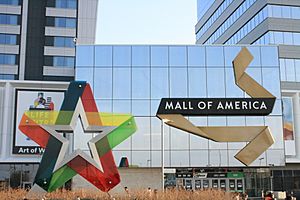
Here are the top employers in Bloomington, based on a 2023 report:
| # | Employer | # of Employees |
|---|---|---|
| 1 | Mall of America (Tenants) | 11,000 |
| 2 | HealthPartners | 3,533 |
| 3 | Bloomington School District #271 | 1,950 |
| 4 | Seagate Technology | 1,365 |
| 5 | Toro | 1,150 |
| 6 | Donaldson Company | 1,126 |
| 7 | General Dynamics | 775 |
| 8 | NCS Pearson | 683 |
| 9 | Ziegler | 675 |
| 10 | GN Resound | 660 |
Other big employers include Express Scripts, Holiday Stationstores, Thermo King Corporation/Ingersoll Rand Inc., and Polar Semiconductor Inc.
Education in Bloomington
The Bloomington School District (ISD 271) takes care of education from pre-kindergarten to 12th grade. It has 15 public schools and an online school. A school board with seven members leads the district. In 2021, Eric Melbye became the Superintendent. In 2006, the city's first public charter school, Seven Hills Preparatory Academy, opened.
The district has two main high schools: John F. Kennedy High School in the east and Thomas Jefferson High School in the west. New Code Academy is an online high school for students anywhere. Students usually go to the high school closest to them, but they can choose to go to either.
| Public schools in Bloomington | ||
|---|---|---|
| Elementary schools | Middle schools | High schools |
| Hillcrest Community | New Code Academy | John F. Kennedy |
| Indian Mounds | Olson | Thomas Jefferson |
| Normandale Hills | Oak Grove | New Code Academy |
| New Code Academy | Valley View | |
| Oak Grove | ||
| Poplar Bridge | ||
| Ridgeview | ||
| Valley View | ||
| Washburn | ||
| Westwood | ||
Bloomington's third high school, Abraham Lincoln High School, closed in 1982. Bloomington Stadium, next to the old high school, is still used by both Kennedy and Jefferson High Schools for sports like football, lacrosse, and soccer.
Private Schools
- Bloomington Lutheran School is a Christian school for grades K-8.
- Nativity of Mary School is a Catholic school.
- United Christian Academy offers Christian education for grades K-12.
Colleges and Universities
- Normandale Community College is a two-year college with about 18,000 students. It opened in 1968.
- Northwestern Health Sciences University teaches about alternative health care, like chiropractic and acupuncture.
- Bethany Global University is a Christian school that trains missionaries.
- Rasmussen University offers many programs for associate and bachelor's degrees.
Population and People
| Historical population | |||
|---|---|---|---|
| Census | Pop. | %± | |
| 1860 | 424 | — | |
| 1870 | 738 | 74.1% | |
| 1880 | 819 | 11.0% | |
| 1890 | 959 | 17.1% | |
| 1900 | 1,085 | 13.1% | |
| 1910 | 1,161 | 7.0% | |
| 1920 | 1,330 | 14.6% | |
| 1930 | 2,655 | 99.6% | |
| 1940 | 3,647 | 37.4% | |
| 1950 | 9,902 | 171.5% | |
| 1960 | 50,498 | 410.0% | |
| 1970 | 81,971 | 62.3% | |
| 1980 | 81,831 | −0.2% | |
| 1990 | 86,355 | 5.5% | |
| 2000 | 85,172 | −1.4% | |
| 2010 | 82,893 | −2.7% | |
| 2020 | 89,987 | 8.6% | |
| 2023 (est.) | 87,398 | 5.4% | |
| U.S. Decennial Census 2020 Census |
|||
In 2020, Bloomington had 89,987 people. There were about 38,080 households. The city is home to people from many different backgrounds. About 69.3% of the people were White. About 9.9% were African American. About 6.6% were Asian. And about 9.9% were Hispanic or Latino.
The average household had 2.33 people in 2022. The average rent was $1,426. The average household income was $87,381. About 7.9% of the people in the city live below the poverty line. Many people in Bloomington have a college degree.
The most common backgrounds reported by people were German (22.7%), Norwegian (12.2%), and Irish (8.3%). The average age in the city was 40.0 years old.
Getting Around Bloomington
The Metro Blue Line is a light rail train. It connects the Mall of America in Bloomington to downtown Minneapolis. It also stops at both terminals of the Minneapolis–Saint Paul International Airport.
Bloomington also has three Bus Rapid Transit (BRT) lines. The Metro Red Line goes between the Mall of America and Apple Valley, Minnesota. The Metro Orange Line goes through Bloomington on I-35W. The Metro D Line connects the Mall of America to Brooklyn Center Transit Center through downtown Minneapolis.
Arts and Entertainment
Museums
- The Works is a museum where kids can learn about technology through hands-on activities.
- The Bloomington History Museum teaches about the city's past, from ancient times to today.
- The NWA History Museum shows the history of Northwest Airlines.
Theater
- Artistry is a group that puts on musicals and plays. They perform at the Bloomington Center for the Arts.
- Normandale Community College's theater program puts on five shows each school year.
- The high schools, Jefferson and Kennedy, also put on several plays and musicals every year.
Visual Arts
- Artistry also has two art galleries at the Bloomington Center for the Arts.
- Mhiripihri Gallery shows sculptures from Zimbabwe.
Public Art
Bloomington has many cool public art pieces:
- "Creating Together" is a mural by Erik Pearson at the Bloomington Center for the Arts.
- "Convergence" is a sculpture by James Brenner from 2015.
- "Seasons of Becoming" is a mural at Wright's Lake Park. Students from Valley View Middle School helped create it.
- The "WE Mural" was finished in 2021. It's a collection of murals in the South Loop District.
- The "Goldfinch" sculpture was installed in 2021. Artist Donald Lipski was inspired by the many birds in the nearby Minnesota Valley National Wildlife Refuge.
Television and Film
Comcast provides four local TV channels for Bloomington. The Bloomington Channel 14 shows city information and programs. BEC-TV shows educational programs from schools. BCAT is a public access channel where people can learn to make TV shows.
Parts of the movie A Serious Man were filmed in an East Bloomington neighborhood. The area looked like a new 1960s neighborhood.
Sports and Fun
Hyland Park has a ski area and Nordic ski jumps. These ski jumps are maintained by the Minneapolis Ski Club. Several U.S. Olympic ski jumpers have come from this club. The city also runs the Bloomington Ice Garden (BIG). It has three ice rinks, including one that is Olympic-sized. The movie Miracle showed a team practicing there. In winter, the Parks and Recreation Department makes over 10 outdoor ice skating rinks.
Pickleball became popular in Minnesota starting in Bloomington around 2005. Retirees brought the sport back from warmer states. Bloomington is also home to Pickleball Minnesota, a website for players in the state.
Bloomington has two big sports complexes. Dred Scott Playfields has baseball, softball, football, volleyball, tennis, and basketball courts. It also has a batting cage and a miniature golf course. Valley View Playfields has softball and baseball fields, and the Bloomington Family Aquatic Center. Bush Lake Beach is open in the summer for swimming.
Famous People from Bloomington
Many well-known people have lived in Bloomington, including:
- Cole Aldrich, an NBA basketball player.
- Tom Burnett, a passenger on United Airlines Flight 93.
- Kelly Carlson, an actress and model.
- Pete Docter, a film director and animator known for Monsters, Inc. and Up.
- Verne Gagne, a famous professional wrestler.
- Tom Gilbert, an NHL hockey player.
- Bud Grant, a retired professional football coach for the Minnesota Vikings.
- Kent Hrbek, a retired Minnesota Twins baseball player.
- Erik Johnson, an NHL hockey player and Olympian.
- Lane Kiffin, a college football coach.
- Tony Oliva, a retired Minnesota Twins baseball player.
- Zach Parise, an NHL hockey player.
- Mod Sun, a singer, songwriter, and rapper.
See also
 In Spanish: Bloomington (Minnesota) para niños
In Spanish: Bloomington (Minnesota) para niños


